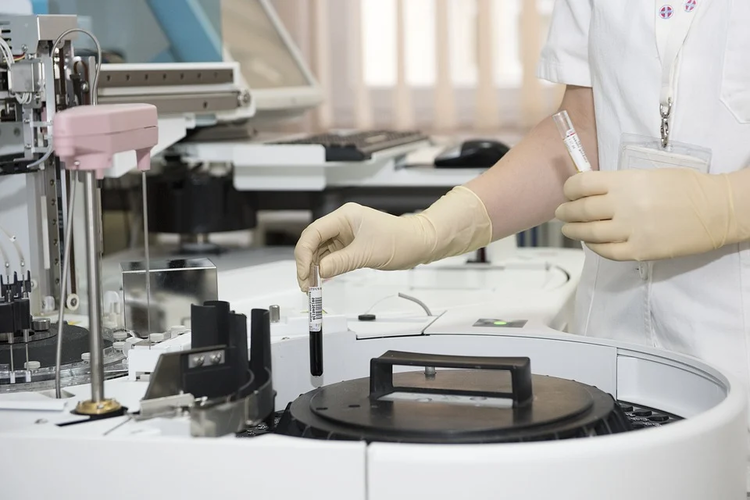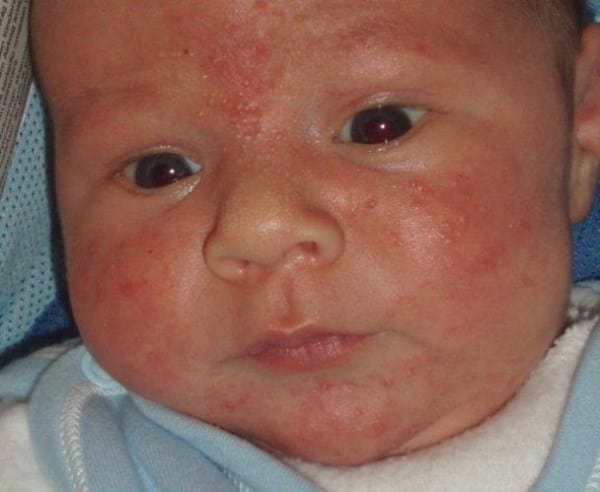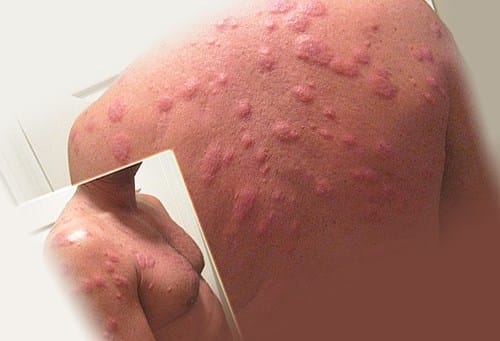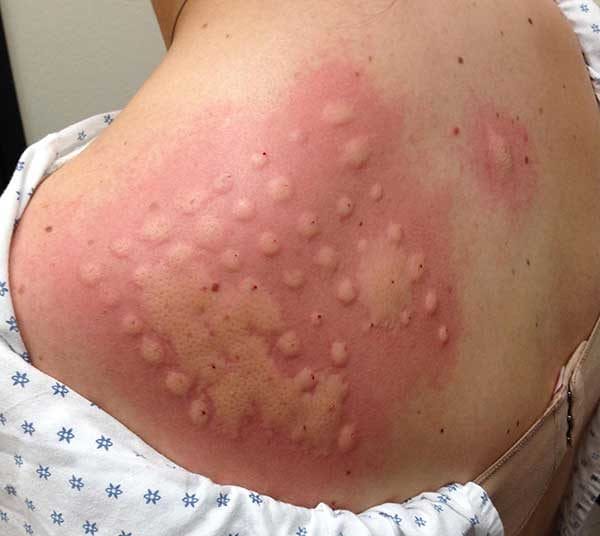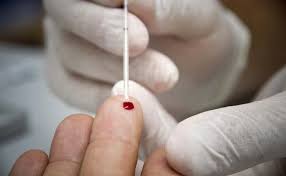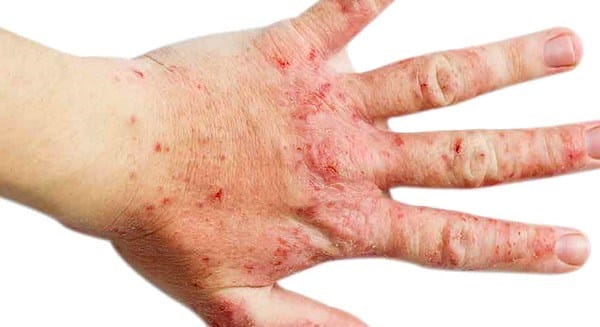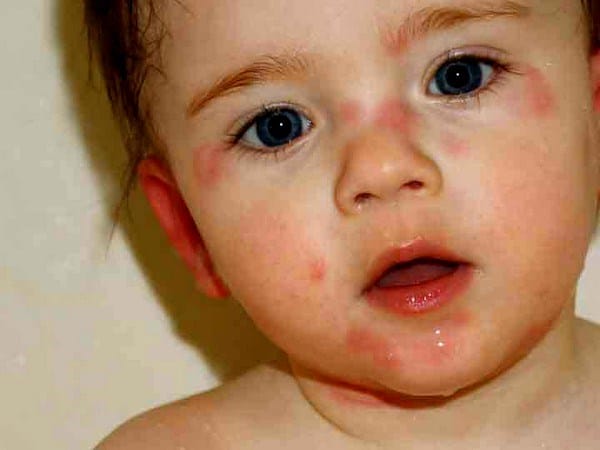What can cause pathology in children and adults?
Substances whose effect on the body causes an adverse reaction are called allergens. They are usually organic, but not required. An adverse reaction can develop to dust, pollen of some plants, food, animal dander, drugs. Typically, an allergen acts on the body for a long period of time, which causes an increase in sensitivity to the irritant. This process is called sensitization.
Allergies are divided into the following types depending on the irritant:
- food;
- pollen (hay fever, or seasonal allergic conjunctivitis);
- on natural phenomena;
- medications;
- chemicals (household chemicals, industrial toxins);
- household allergies (animal dander, mold, dust).
Polyvalent allergy occurs as a result of exposure to not one, but several allergens at the same time. In this case, several types of reactions can be observed. Polyvalent allergies are fairly common.
There are several reasons for the development of allergies, but researchers still cannot determine the exact ones. Some doctors blame unfavorable heredity for the development of the disease, because if a child has one or both parents suffering from allergies, then it is very likely that he will become allergic. Others argue that drug abuse, bad habits, or the environmental situation have a great influence on its development.
The main symptoms
When an allergen enters the body, the immune system is activated, immunoglobulins begin to be released, antibodies and mast cells are synthesized – special cells of the immune system. In the last phase of an allergic reaction, histamines and cytokines, inflammatory mediators, are released. Their number is determined by the intensity of the body’s reaction.
Allergies can manifest themselves in different ways. It all depends on the individual characteristics of the organism, the type of allergen and the route of entry into the body. Dust, aerosols and pollen commonly cause inflammatory dermatological diseases, allergic rhinitis (runny nose), asthma, airway swelling and lacrimation. The most dangerous manifestations of allergies include anaphylactic shock, bronchial asthma and Quincke’s edema. If the patient is not delivered to the clinic in time, complications can be fatal.
Foods can cause abdominal pain, vomiting and nausea, swelling of the mouth, and gastrointestinal disturbances. This type of allergy must be distinguished from intolerance, in which the patient lacks the enzymes necessary to assimilate certain nutrients. There is also a psychological intolerance to food. In all cases, the patient complains of gastrointestinal disorders, but the immune system is not involved in this process.
The list of typical symptoms that patients call allergies include:
- hives;
- swelling;
- pain in the eyes;
- cough;
- nasal congestion;
- chihanye.
With constant exposure to the allergen, loss of consciousness, disorientation, anaphylactic shock, etc. are possible. The most common symptoms may indicate another disease. In this case, antihistamines will not provide relief. It is necessary to undergo a diagnosis in order to accurately determine the causes of the symptoms that have arisen.
How to identify the type yourself?
How to determine what you are allergic to? The easiest way is to identify a food allergen on your own. Acute manifestations of the disease can be relieved by following a strict diet. Then the patient needs to be transferred to a mono-diet that includes only water without gas and one product to which there is definitely no adverse reaction. New products are added one at a time every two to three days. In this case, the state of a person must be recorded. In this way, all food allergens can be identified one by one.
How to understand what the allergy is, if food does not cause a deterioration in well-being? You will have to keep a diary in which you need to reflect the events of the day and record your well-being. Gradually, patterns in the manifestation of signs of allergy may come to light. For example, irritation on the skin after using a certain sunscreen, red spots on the places where the perfume was applied. If the child breathes easier after wet cleaning and coughs less, then the problem may be house dust.
Home Diagnostic Tests
How to check if there is an allergy? Pharmacy chains sell special express tests designed for self-use at home. A small amount of blood is applied to the strip. If a reaction to any allergen is detected, a plus appears in the information window, if it is absent, a minus appears. The test result is known within 30 minutes. The range of allergens in such allergy tests is limited and the accuracy is insufficient. So you should not rely solely on express tests for diagnosis.
Laboratory research methods
How to determine what you are allergic to? You need to consult a doctor who will assess the patient’s condition, prescribe the appropriate diagnostic procedures and a therapy regimen. Consultation with an allergist is mandatory for children and adults. Even if a person knows exactly what he is allergic to, it is recommended to take tests to verify the diagnosis, identify possible additional allergens and correctly prescribe treatment. Most often, skin tests for allergies and blood tests are done.
General clinical blood test
This analysis (OAC) allows you to differentiate an allergic reaction. Symptoms such as hives, rashes, or eczema can indicate a dermatologic condition, and respiratory allergies often have the same symptoms as an upper or lower respiratory tract infection. To accurately determine that the patient is suffering from an allergic reaction, and not from another disease, a CBC is prescribed.
Blood is taken in the morning before breakfast. The last meal should be twelve hours before the test. After taking the biological material, laboratory technicians count the number of special cells – eosinophils. There should be no more than 5% of them in the blood if the person is healthy. An increase in indicators indicates the likelihood of allergies, but can also be observed with parasitic lesions. Therefore, the complex is assigned an analysis to identify parasites. If they are not there, then an allergy is diagnosed by exclusion.
General clinical blood test to identify allergies
If you suspect that you have an allergy, your doctor will start by ordering a complete blood count for the allergy. He surrenders in the morning on an empty stomach, that is, the last meal should be 12 hours before the analysis and no later.
This analysis is aimed primarily at counting special cells – eosinophils. In the blood of a healthy person, the content of these cells does not exceed 5%. If there are much more of them, this gives the right to suspect an allergy. But not only – increased eosinophils are also characteristic of some parasitic lesions, so, in addition to an analysis for allergies, the doctor will also prescribe an analysis to identify parasites. If they are not found, then allergy is assumed by the method of exclusion. In this case, the doctor will give a referral for immunoglobulin E.
Blood test to determine total immunoglobulin E
Immunoglobulins are antibodies that neutralize foreign cells. These are, one might say, the soldiers of our defense system. However, their activities sometimes turn against us. To find out if this has happened to you, an analysis is prescribed for the content of total immunoglobulin E. In order for the results to be accurate, you should prepare for the examination – 3 days before the analysis, it is better to avoid physical exertion, stress and overheating, do not drink alcohol. Do not eat and smoke 12 hours before the test.
Immunoglobulin E is found in the blood in very small amounts. Its level changes with age. Here are the norms for the level of this immunoglobulin for different categories:
- Newborns (up to 2 years old) – 0–64 mIU / ml.
- Children from 2 to 14 years old – 0-150 mIU / ml.
- Children over 14 years old – 0-123 mIU / ml.
- Adults under 60 years old – 0-113 mIU / ml.
- Adults over 60 years old – 0-114 mIU / ml.
If the level of immunoglobulin E is too high for the age category of the patient, then there is an allergic reaction in the body. The higher this figure, the more contact with the allergen.
Blood test to detect specific immunoglobulins G and E
If previous tests only helped to identify the very fact of the presence of an allergy, then a blood test to detect specific immunoglobulins G and E gives more accurate information about the disease. The rules for preparing for blood donation for specific immunoglobulins G and E are the same as for testing for total immunoglobulin. But the research itself in the laboratory is carried out in a completely different way.
Blood is divided into small portions and mixed with various allergens – components of pollen, mold spores, pet hair and feathers, various foods and chemicals. The number of substances under study can be up to 190! The specialists then examine the blood samples and calculate the immune response. The higher it is, the more dangerous a certain product or substance is to you. The reaction can be of three types – low, medium and high. A low answer means that the substance is safe, medium – that you should avoid the substance or at least not get carried away with it when it comes to food, and a high answer means that this particular product causes an allergic reaction and contact with it must be completely excluded.
The results will be given to you in the form of a large table, and you can see for yourself which substances are dangerous to you.
By the way,
among foodstuffs, allergies are most often caused by nuts, peanuts (it does not belong to nuts, but to legumes), red berries, chicken, eggs, seafood and cheese.
How to know what you are allergic to
To find out what you are allergic to, you need to analyze your lifestyle. If you found the manifestations of this disease today, then you need to remember what new you ate yesterday, with what objects you contacted. Through trial and error, over time, it is possible to identify the allergen by eliminating certain environmental factors and observing the body’s response.
With the help of special tests sold at the pharmacy, allergies can be detected. This is a convenient method, but not as reliable and informative as laboratory diagnostics.
As for young children, here experts recommend keeping a food diary, where the allergen is also detected by the method of exclusion, is excluded from the diet and after a while is gradually reintroduced in small doses.
Allergy symptoms, depending on the pathogen.
Many, having endured the symptoms of an allergic reaction, do not even know what they were sick with. The manifestations of the disease can be so similar to other diseases that medical errors in the diagnosis are not excluded. But there is one difference: all allergy symptoms appear against the background of absolute health and progress very quickly. Any other disease does not behave this way.
To recognize the signs of an illness in a healthy person, you need to know the main symptoms of the manifestation of the disease. Allergies are classified into three main types:
- respiratory;
- leather;
- food.
Each species has its own symptoms of the disease, but they are all the body’s response to the invasion of an alien pathogen. The immune system begins to produce large amounts of histamine, as a result of which all the signs of the disease are “on the face.” How to recognize an allergy in an adult? Let’s figure it out.
How to identify respiratory allergy in an adult?
During inhalation, thousands of tiny particles enter the body along with the air, which can cause the development of a respiratory form of allergy. Respiratory allergy can be attributed to the respiratory tract, which is often taken as ARVI or bronchitis. How do you know what an adult is allergic to if it looks like a respiratory illness? It is accompanied by the following symptoms:
- itchy nose;
- chihanye;
- coughing;
- hoarseness;
- may be choking.
- conjunctivitis.
Against the background of these signs of the disease, bronchial asthma and allergic rhinitis may develop. Allergic bronchial asthma is primarily associated with the work of the respiratory tract and has the following symptoms:
- a strong cough appears
- whistling when inhaling and exhaling
- difficulty and rapid breathing
- a feeling of tightness in the chest
- chest pain
These symptoms can appear when irritated by any allergen (pollen, dust, wool, etc.). According to the severity of the attack, asthma is divided into mild, moderate and severe. An extreme condition that can cause atopic bronchial asthma is status asthma. This is a very dangerous human condition, when spontaneous breathing is almost impossible. Accompanied by clouding of consciousness or complete loss of consciousness. May be fatal.
Skin allergy and its manifestations
Skin allergy
Along with the respiratory manifestations of allergic reactions, skin reactions can also occur, which are visible to the naked eye and make one think about the cause of the occurrence. The skin is the largest organ in our body, it occupies the largest area. Therefore, it contains the largest number of nerve endings that react differently to external stimuli.
There are several types of skin allergies:
- contact allergy;
- eczema;
- toxidermia;
- atopic dermatitis;
- hives.
Anything can be the cause of a skin reaction: food, food coloring, plants during flowering, chemicals, insect venom, medicines, some metals. The timing of allergies may vary. Sometimes the reaction is immediate, sometimes it takes 2-3 days before the first symptoms appear.
Contact allergy arises precisely from direct contact with the allergen. An example is the metals we love to wear as jewelry. Some precious metals cause allergic reactions just like regular jewelry. In places of contact, a rash, hyperemia of the skin, itching, peeling appears. How to find out what an adult is allergic to if there are skin problems? It is enough to see a doctor and undergo tests and examinations.
Allergic eczema is a long-term ongoing disease. Most often, it is characterized by manifestations of almost all forms of skin allergies, from redness to severe itching and flaking. The rash merges into a solid crust, when combing, weeping wounds appear, bringing discomfort to the patient.
Toxidermia is another manifestation of an allergic nature that affects the surface of the skin. However, it occurs when an allergen enters the body directly by food poisoning, intravenous or intramuscular administration of a medicinal product, or through the respiratory tract. It manifests itself as a papular or bullous rash on the skin and mucous membranes.
Hives gets their name from the common nettle plant. It is after a nettle burn that whitish blisters remain on the skin, which are accompanied by burning and unbearable itching. Such rashes on the skin are also characteristic of skin allergies.
Allergy with lesions of the gastrointestinal tract
When an allergy provoked damage to the gastrointestinal tract, the following symptoms may appear:
- nausea;
- vomiting;
- diarrhea;
- constipation;
- swelling of the lips;
- swelling of the tongue;
- intestinal colic.
As a result of the appearance of such an allergy, anaphylactic shock may occur, in which a person becomes dull, or faints, his blood pressure drops, breathing stops, involuntary urination occurs, and some other symptoms.
Climatic conditions also affect the occurrence of allergies. After all, light, cold, heat allergies are closely related to the climate of the geographic zone in which a person lives. The climate is also important for people with hay fever.
So, for example, Western Europe is a place of growth of plants that cause pollinosis. Moreover, in different parts of the continent, there is a different intensity of these diseases.
Plane and ash, ferns and grasses grow in the northern part of France, the pollen of which can cause allergic reactions.
Industrial areas of large cities are also considered to be the places of outbreaks of allergic diseases. These zones are dangerous both because of the high concentration of emissions of harmful substances into the air, and because man-made emissions suppress the immune system, make a person even more susceptible to various diseases.
The onset of new allergy symptoms can be caused by factors such as:
- Place and specifics of work. It has a great influence on the occurrence of allergies, since constant contact with chemicals, wood dust, chemicals, latex, lubricants can provoke the appearance of red spots on the skin, which are accompanied by itching. Sometimes a change of place of work can lead to the fact that new allergens begin to influence the human body or old ones increase their influence.
- Moving. Any change in the meta of habitation, whether it be business trips, moving to another apartment, district, city, country, can provoke the occurrence of allergic reactions. An allergic reaction can be triggered by mold, dust mites, animal hair. It can appear immediately or after several years.
- Food allergy syndromes. With hay fever, there are often cases when a person has allergic reactions in the oral cavity in the form of itching or inflammation of the mucous membranes. Such a reaction can occur to those foods that you have previously eaten more than once.
- Eating fish and other seafood. In an adult, an allergic reaction also occurs due to the consumption of seafood – crabs, lobsters, shrimps.
Diagnosis of allergic diseases: a review of research methods
In the treatment of allergies, it is important to identify provoking substances. For this, various diagnostic measures are carried out.
Tests for the detection of allergens are taken in the allergy department of clinics. There are different methods for diagnosing allergic diseases.
Which one to choose is determined by the doctor after examining the patient. Allergens are detected by examining cutaneous reactions or a blood test.
Samples are divided into types:
- Provocation. The patient is injected with a small dose of the allergen and the body’s reaction is monitored.
- Direct research. Allergens are detected using cutaneous tests without the introduction of an allergen.
- Indirect test. The allergen is injected under the skin, and then a blood sample is taken and examined.
If a person has a sensitivity to a certain substance, then the skin will become inflamed upon contact with the allergen. Thus, you can find out which of the alleged substances is a provocateur of allergic reactions.
Several types of cutaneous tests are performed:
- Scarification (cuts, scratches). It is performed on the area of the forearm where allergens are applied (no more than fifteen), and then small incisions are made in these places. If the skin of one or more incisions has become swollen, it means that an immune response is provoked to these substances.
- Application. Strips with allergens are applied to the skin of the hand and fixed with a plaster. The reaction to substances is observed for two days. If it manifests itself within a few hours, then we can talk about an immunocomplex type of reaction, and if after a day or more – about a slow one.
- Injection. Substances are injected under the skin and the reaction of the body is monitored.
With any immune response, specific antibodies are released into the blood. To detect allergies, the blood is examined for the presence of IgE antibodies. In this case, the alleged allergens are not injected into the patient’s body, all studies are carried out after blood sampling.
Blood for the test is taken from a vein. Then serum is separated from it and the material is placed in test tubes with allergens. If there are antibodies to a substance, then they enter into a bond. In the case of a positive response, the person is confirmed to have an allergic status.
There are two research methods:
- Multiple allergensorbent test. A fluorescent dye is added to the test materials, which produces a luminescent glow. The result is determined by a photograph of the material.
- Radioallergosorbent test. A radioactive isotope is added to the test tubes. Revealing the result is carried out in a special apparatus.
The results are interpreted by the level of IgE antibodies. If it is within normal limits, then there is no allergy. A slight excess of indicators indicates the presence of an immunopathological process. If the level of antibodies is very high, then this indicates a strong allergic reaction. After confirming the diagnosis, the doctor prescribes treatment: prescribes antihistamines and talks about preventive measures.
Methods of stimulation or provocation
These diagnostic studies are used only if skin tests do not make it possible to establish the cause of the disease.
The suspected allergen is injected directly into the organ that is affected by the allergy.
If signs of a disease appear, it can be judged that it is this substance that provokes an allergy.
This method is especially useful for detecting bronchial asthma and hay fever. It is sometimes also used to diagnose food allergies.
There are such stimulation methods:
- nasal provocation. This technique is used to determine the cause of persistent rhinitis. Usually, it can be used to identify the component of house dust, which provoked the allergy;
- bronchial provocation. Testing involves inhaling the suspected allergen and is often done with a spray bottle. Pulmonary function is measured to assess the patient’s response;
- food provocation. In the first stage of the investigation, the suspect product is excluded. After the signs of the disease disappear, the food is returned to the menu, however, it is enclosed in a special capsule so that a person cannot taste the contents.
Then the patient’s well-being is monitored. After a few days, the process is repeated, but a non-allergenic substance is enclosed in the capsule. This double-blind test eliminates subjectivity on the part of the doctor and patient.
Allergy Causes
- the main place in the appearance of the disease is still occupied by the human immune system. Immunity is the protector of the whole organism from dangerous elements. With allergies, the system crashes;
- experts also argue that the gastrointestinal tract plays an important role in the development of allergic reactions. If this system malfunctions, allergens are not normally digested and converted into amino acids, but enter the bloodstream.
- do not forget about the effect of the liver. If its cleansing function decreases, the risk of developing sensitization increases significantly;
- renal failure may be another cause. As a result, the kidneys simply cannot cope with their immediate task – the excretory function.
In babies, such a reaction can occur due to an early transition to artificial feeding.
In addition, if a woman during pregnancy or breastfeeding abuses the use of foods that provoke the development of allergic reactions (citrus fruits, nuts, chocolate, eggs, coffee …), smokes, drinks alcohol, the child will have a predisposition to the appearance of an illness.
Another leading role is played by heredity.
The likelihood of developing the disease in children whose parents suffer from allergies is quite high.
Smoking allergizes absolutely every person, it’s only a matter of time. Women are more prone to early onset of allergic symptoms.
It is also worth remembering about the harmful effects of fungi, which increase the sensitivity of the body.
Also, the disease has a professional aspect. Hairdressers, consultants for household chemicals, workers in industrial plants are all at risk.
Diagnosis of allergic signs in adults
An adult can independently exclude an allergen – for this it is necessary to listen to your body, to restore in memory what contributed to the allergic reaction: food, contact with animals, toxic substances and other types of antigens.
It will not be difficult for an adult to exclude food allergies: it is necessary to remove possible allergens from the diet – commonly consumed foods. After a few days, a reaction is noticeable – a decrease or renewal of symptoms.
In the absence of symptoms, foods should be introduced into the diet gradually and separately in order to notice the body’s response to the product.
In case of an allergic reaction to household chemicals, jewelry, cosmetics, you should proceed in the same way: cancel washing with powder – a suspected allergen, do not wear clothes, jewelry with the metal to which you are likely to be allergic.
If, after putting the object into operation, eating food, contact with an animal, an allergic reaction appears, it is necessary to permanently exclude the allergen to prevent aggravated conditions.
Before starting treatment, an adult needs to visit an allergist, who will take an anamnesis from the patient’s words, take into account heredity, and direct all the necessary tests.
Treatment
Allergic signs are treated individually, based on the characteristics of a particular adult. First of all, contact with the allergen is excluded.
For allergic symptoms, symptomatic treatment and elimination of the root cause of the disease are indicated. To eliminate allergic signs, the doctor prescribes non-hormonal and hormonal agents that fight edema, itching, inflammation, and have a sedative and sedative effect.
The most common medicines to combat allergic symptoms are:
- antihistamines sedatives – Suprastin, Tavegil, Diphenhydramine;
- non-sedative antihistamines – Telfast, Claritin, Cetrin, Erius;
- metabolizing drugs – Cetrin, Zodak, Zyrtec.
Preference is given to drugs without sedation and metabolites, mainly anti-allergic drugs of the latest generations, which do not have side effects when used, but at the same time they act instantly.
Antihistamines are divided into several types, which can be used not only orally, but also intranasally, in the form of eye, nasal drops, ointments, creams.
For allergic symptoms, immunotherapy is effective – careful contact with the allergen, gradually increasing the dosage. Thanks to immunotherapy, the adult’s body blocks antibodies, as a result of which a person gets used to the allergenic substance, and there is no reaction to allergens.
Folk remedies also relieve allergic symptoms in adults. But, it should be borne in mind that the composition of alternative medicine often includes medicinal herbs that provoke allergic symptoms.
Preventive measures for allergic symptoms
In order to stop the signs of pathology in a short time, adult allergy sufferers should always carry an antihistamine with them. At home, you should also provide a healthy atmosphere: do not use household chemicals with a lot of toxins, remove plants that provoke allergic symptoms, and exclude contact with pets.
If an adult suffers from hay fever – seasonal allergic symptoms, upon returning home, you need to wash your hands, rinse your throat and wash your face with rinsing your eyes, or better, take a contrast shower.
For the prevention of allergic symptoms, adults should be tempered, play sports, strengthen the immune system, stop drinking alcohol and cigarettes, use ionizers, air purifiers and humidifiers at home. At the first allergic signs, it is necessary to consult a specialist for diagnosis and proper treatment of the disease.
How to find out what is allergic to in adults?
In case of signs of allergies, it is best to contact a specialist.
In this case, see an allergist. How to find out what an adult is allergic to? Currently, medicine has a sufficient arsenal of methods for determining its circumstances. These include skin tests. Their essence is that allergens in their pure form and in small quantities are injected under the skin of the forearm.
Skin tests are divided into three types:
-
Scarification test. In this case, non-bleeding scratches are left on the skin with needles or lancets, which are covered with a drop of the allergen.
-
Intradermal test.
The irritant is injected with a syringe.
-
Trick is a test. This test is done with an injection.
How else to find out what an adult is allergic to? There is such a method as a provocative test. It gives more information and is indicative. Such a test involves the introduction of an allergen into the organ most affected by allergies. It is called shock.
How to find out what you are allergic to? The most effective method for determining an allergen is a blood test for the presence of IgE antibodies in it.
To carry it out, an unhealthy person needs to donate a small amount of blood from a vein.
How to find out what the allergy is, using the out-of-laboratory method
If there is no ability or desire to contact a specialist, then you can identify the allergen at home. Currently, pharmacies provide different tests for these purposes. They are a strip on which blood is applied. If a plus appears on it, then there is a reaction to the allergen, a minus is not. But this method is dubious and unreliable.
How to find out what a child is allergic to?
Children over 3 years of age may be subject to laboratory testing for allergens. In some cases, the permissible age increases to 5 years.
The methods are not sufficiently different from those carried out with adults.
How else to find out what the child is allergic to? It is also possible for parents to keep observations and write them down in a diary. This will be great, since allergies arise not only from food products, but also due to the influence of other reasons. Infants should be treated differently.
Survey methods
An allergist is responsible for examining, prescribing tests and further treatment of patients with allergic reactions.
After finding out all the manifestations of the disease, the date of its onset, hereditary predisposition, the characteristics of the course, examination methods are selected.
Allergens are currently identified by two methods, these are:
- In vitro (in vitro) – that is, the direct participation of the patient during the diagnosis is not required. All that is needed is a pre-obtained blood serum.
- In vivo – diagnostics, during which the subject himself must be present. This examination method includes skin and provocative tests.
Allergens and predisposition to them are established using:
- Scarification skin tests.
- Establishment of the presence of specific immunoglobulins and Ig antibodies in the serum E.
- Provocative tests.
- Elimination tests. Under this method, the examination is supposed to exclude contact with a possible, often food, allergen.
When establishing a suspected allergen, certain difficulties often arise, due to the fact that in recent decades, a single-component allergy, that is, a reaction to one irritant, has been extremely rare.
In most cases, similar allergic reactions are cross-linked, that is, they develop to several types of allergens, the so-called polyvalent allergy.
In order to establish all of them accurately, a comprehensive examination is required with the appointment of several types of analyzes at once.
What tests are taken for allergies
Examination of a patient with allergic reactions is usually always standard, it is mandatory to appoint:
- General blood analysis.
- A blood test to determine the level of total immunoglobulin E (IgE).
- Analysis for the determination of specific antibodies of the classes of immunoglobulins G and E (IgG, IgE).
- Skin tests to determine the allergen.
- Application, provocative and elimination prick tests https://allergiik.ru/prik-test.html.
Quite often, only a complete examination allows the allergist to establish exactly for what reasons the disease develops, and what treatment methods will be the most effective.
Preparation before analyzes
Serum tests for allergens must be performed under several conditions. Failure to comply with them leads to obtaining unreliable results. The doctor must explain to the patient all the nuances of the preparatory measures.
Before taking blood, only a few conditions must be observed:
- Blood is donated only during periods of remission. During an exacerbation of an allergic reaction, antibodies will certainly be increased, and this will distort the test results.
- An analysis for allergens is not passed during the course of viral, colds, respiratory diseases. The examination will have to be postponed also in case of exacerbation of chronic diseases, at temperature and in case of poisoning of the body.
- A few days before the tests and tests, they refuse medication, including antihistamines. In cases where the withdrawal of drugs due to a severe course of diseases is impossible, blood is donated only after consultation with an allergist.
- At least three days before blood sampling, all contacts with pets – birds, animals, fish – cease.
- Five days before the diagnosis, all foods with a high degree of allergenicity should be excluded from the diet, these are honey, chocolate, whole milk, nuts, citrus and exotic fruits, seafood, vegetables, berries and fruits with a red color. Also, at this time, you should not eat products made with preservatives, flavor enhancers, flavors, dyes.
- The day before the day of the examination, it is necessary to reduce the intensity of physical activity, especially with regard to sports training.
- The last meal should be no later than 10 hours before the test.
- On the day of the examination, they give up coffee and smoking.
Skin tests
Skin tests for allergens are carried out in several ways, these are:
The patch test is considered the least invasive test method. They usually walk with a glued plaster for two days, after which the doctor assesses all the changes.
The application method of examination is most often used for allergic dermatitis.
Peak test and skin scarification allow obtaining examination results within 15-20 minutes, if during this time skin changes appear in the form of swelling, redness, itching, it means that the human body is sensitive to these substances.
These tests can identify up to 15 possible allergens at a time.
A scarification test and a peak test are not always prescribed, since there is a possibility of allergens entering the body, which can result in anaphylactic shock.
Contraindications to the appointment of these tests:
- The child’s age is under 5 years old;
- Identification of cases of anaphylaxis during a conversation with a patient;
- Pregnancy and lactation period;
- The period of treatment with hormones;
- Age over 60;
- Exacerbation of cardiac, nervous, allergic, gastrointestinal diseases.
Interpretation of allergy tests
The criteria for allergic changes in the research results are different indicators for allergen-specific immunoglobulins. Let’s consider each of them in more detail.
- The amount of class E immunoglobulins (IgE) in the blood depends on age:
- in young children, this figure does not exceed 35 IU / ml,
- in adults – no more than 100 IU / ml,
- in adolescents, a level of up to 200 IU / ml is considered the norm.
- The level of specific immunoglobulins (IgG) for each allergen is determined separately.
Allergy classes by blood test
According to the level of immunoglobulins in the blood serum, allergies can be conditionally divided into several classes:
- O class – immunoglobulins are not detected, in fact, there is no allergy;
- I class – the level of immunoglobulins slightly exceeds the reference values, the manifestations of allergies are minimal, a chronic allergic reaction is possible;
- Class II – Ig level is higher than normal, symptoms of the disease are quite pronounced;
- III class – the amount of Ig is off scale, a pronounced course of the allergic process, exacerbation of allergies.
Description, types of allergens
Any substance can be an allergen. The most common:
- Drug allergy.
- Household allergens.
- Fungal.
- Epidermal (cutaneous).
- Food allergens of plant origin.
- Food allergens of animal origin.
- Food preservatives.
- Food colorings.
- Allergy to pollen.
- Allergens of trees, meadow and weeds.
Allergy indicator in the general blood test
It is quite easy to draw blood for a clinical blood test from a fingertip if you suspect an allergic reaction.
- This test is most often done when a child’s allergy is suspected.
- A typical change and indicator of allergy in the general blood test is an increased level of eosinophils – a type of white blood cell that is responsible for the formation of some types of allergic reactions.
- Normally, their number does not exceed 5% of the total number of leukocytes.
- Exceeding this value indicates an active allergic reaction.
What blood biochemistry can tell
A biochemical blood test for the diagnosis of allergic diseases is the least informative indicator. An indirect sign of immunological disorders is:
- an increase in the blood gamma-globulin fraction of the protein.
- Allergy in a child is especially clearly manifested in this way.
- However, the level of these proteins also changes in many other diseases, so it is not worth focusing only on it in terms of diagnosis.
When do you need to donate blood for allergens?
It is advisable to do a blood test in the presence of symptoms of an allergic disease. Symptoms are quite diverse, the main ones are:
- chronic cough
- long-term current conjunctivitis or rhinitis
- skin rashes of unknown origin;
- difficulty breathing
- a sharp drop in blood pressure due to contact with any allergen;
- digestive disorders in the form of diarrhea or constipation;
- suspicion of helminthic invasion.
Blood for allergies must be donated according to the doctor’s prescription, who will not only write a referral to the laboratory, but also conduct a full preliminary examination, including taking anamnesis and examination.
- The diagnosis is made not only on the basis of the results of the analysis, but also on the basis of the patient’s complaints and clinical symptoms.
Preparation and analysis
Analyzes for allergens in adults, the price of which can be high, as with any medical examination, require preparation. In case of emergency, it can be carried out in any conditions, even after taking antihistamines and with acute manifestations of allergy symptoms.
However, such analysis results will not give an adequate assessment of the data obtained and may differ from the results of the same analysis submitted after preliminary preparation.
In general, preliminary preparation for testing for allergens by blood or skin test does not include special steps.
For this:
- for 1 day, you need to exclude spicy, fatty or exotic foods from the diet and adhere to a diet. The last meal on the eve of the test should be completed before 6 pm;
- in 1 day before undergoing the procedure, you should avoid strenuous physical activity and sports;
- it is not recommended to be nervous the day before or before the analysis, therefore, you should calm down as much as possible and tune in to a positive result;
- before donating blood (1-2 days), you need to stop taking any drugs that are not caused by vital necessity. It is imperative to consult with your doctor about taking such medications at the examination in order to exclude side effects on the study result. It is also recommended not to drink alcohol or smoke before the procedure;
- Blood is donated from a vein on an empty stomach or after 4 hours. after the last meal.
A blood test for allergens can be done at the medical center, where 2-5 cubic meters of blood are removed from the vein. ml. blood.
The collected analyzes are immediately transferred to the laboratory for research.
There are 2 main components in the blood:
- total immunoglobulin IgE;
- specific E immunoglobulin.
The first test determines the level of immunoglobulin in the blood.
In this case, the blood is checked for immunoglobulin levels. By the amount of antibodies reflected in the results of the study, the doctor concludes that there is an allergy in the body.
On average, for adults, the average upper level of IgE in the blood should be no more than 100 IU / ml. If it is exceeded, an additional study for a specific immunoglobulin is carried out in order to establish the exact type of stimulus.
In the second case, the blood is tested for specific globulins:
- for this, a small amount of blood is mixed with a substance containing a separate type of irritant;
- after which the level of globulin is measured.
To determine the presence of allergies, the amount of antibodies is checked against the average level of this indicator for this type of analysis. There are tables of indicators of the level of antibodies in the blood, which are used to assess the presence and degree of allergic manifestations.
For the delivery of an analysis for allergens by conducting skin tests, they are prepared in the same way as for the delivery of a blood test for allergens.
However, it is carried out in other ways:
- skin test, in which an irritant substance is applied to the patient’s intact skin;
- Prik test, when a solution with the selected type of substance is dripped onto the skin and then pierced with a needle to a depth of 1 mm in the center of the place where the liquid is applied;
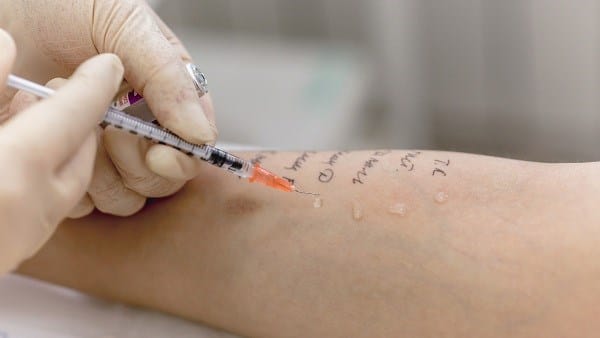
- The scarifier test is a similar procedure. The solution is dripped onto the skin, and then the upper layer of the epithelium is gently scratched several times with a special scarifier (a disposable medical instrument for punctures that resembles a spear).
After any of these procedures, a reaction occurs on the skin of the allergic patient. It can be expressed in different forms, be instantaneous or late manifestation.
A system for qualifying skin reactions has been developed, which makes it possible to clearly establish the presence of a pronounced allergy to certain types of irritants. When redness, rashes, itching appear, the laboratory assistant can not only establish the speed of the body’s response, but also the degree of its reaction, which is very important for understanding the effects of stimuli on the patient’s tissues.
However, there are cases when the skin reaction to certain types of irritants is not significant or quickly disappears. In such situations, it is impossible to say unequivocally about the diagnosis of allergies. For a more accurate examination, an allergen blood test may additionally be prescribed.
Decoding the results
An analysis for allergens in adults, the price of which is determined by the complexity of the study, carried out by blood, allows you to deduce the presence of an allergy in general. To identify the factor of the presence of an allergic component, the level of total immunoglobulin IgE in a blood sample is measured.
Normally, the amount of such antibodies should not exceed 100-110 IU / ml. The lower the amount of IgE in the blood, the less the body reacts to external stimuli. If IgE is more than 150 IU / ml, allergy is diagnosed in the patient. At a higher level, the disease will be acute.
In the case of a study for specific E immunoglobulins, the reaction of blood cells is detected in relation to each group of stimuli separately.
In this case, the level of E immunoglobulin is assessed according to the approved scale:
| IgG4 level in units | Sensitization degree |
| up to 50 | no sensitivity |
| from 50 to 100 | weak |
| from 100 to 200 | middle |
| above 200 | tall |
When an average and high level of the body’s reaction to certain irritant factors is detected, an allergy to certain types of substances is confirmed.
It is impossible to independently decipher the results of skin tests, since the study is temporary.
When conducting skin tests, allergic manifestations are established by a laboratory assistant on the basis of the available scale of skin reactions. After the end of the test, the patient’s skin is completely restored, and the results of the study indicate the degree, type of reaction and its speed.
Regardless of the type of study, only an allergist should decipher the indicators, taking into account the age and state of health of the patient. Since in some cases a deviation of 10 units. will be considered the norm, and in others a significant excess.
Based on the data obtained, the doctor will accurately diagnose, and also prescribe the optimal method of treatment when symptoms of the disease appear.
When to see a doctor
Allergies have a variety of symptoms that manifest themselves to varying degrees in each person. In milder forms of manifestation, a person may generally not notice the presence of allergic manifestations for a long time. In this case, no special treatment is required.
However, in the case when the patient is very worried about the manifestations of allergies, general symptoms of allergic reactions appear or the body’s immune system often fails, you should immediately consult an allergist.
Allergies are diagnosed quite simply by examination and testing. For the rapid disappearance of allergy symptoms, excluding the source of its manifestation is often not enough.
Allergies are treated with a course of antihistamines that block the body’s response and the release of antibodies. Such drugs act mildly and cause a temporary normalization of the immune system. After the symptoms have completely disappeared, taking the drugs can be stopped.
In addition to the course of treatment, the patient is advised to further avoid the irritating factor in order to prevent the recurrence of the disease.
What types of allergic reactions exist today
The types of allergic reactions directly depend on the allergen component
Food allergy. Medical experts classify the following food groups as allergens:
- dry cocoa powder or chocolate;
- cow’s milk (it is a highly allergenic product);
- eggs, especially their protein, you should carefully study the composition of store cookies, pasta and confectionery, since often chicken eggs are among the components;
- fish and any seafood;
- some types of cereals (these include rice and buckwheat);
- cottage cheese (both home and store);
- lactose and products containing it;
- honey;
- mushrooms in any form and broths prepared on their basis;
- any nuts;
- orange or red fresh fruits, vegetables or berries, citrus fruits are considered especially highly allergenic;
- soy products.
Respiratory type allergens. Contact with the allergen is expected by inhalation of various small particles through the nose. These include allergens such as dust, pollen from flowering plants, mold or pet hair.
Dermatosis of the allergenic type. This appearance is manifested as a result of contact with allergens such as low-quality cosmetics, household chemicals. Allergic dermatitis can also occur when exposed to sunlight or after swimming in seawater or chlorinated water. Due to the fact that such a form of it as dermatosis manifests itself immediately, it will not be difficult to identify allergies.
Allergic reactions to taking certain groups of medications. These include antibiotics, vitamins, hormonal medications, analgesics and a variety of vaccines. Identifying a drug allergy can be quite simple, but as soon as it appears once, it will recur again and again.
Allergic reactions of the insect type, which imply the negative reactions of the body to the bites of various insects (wasps, bees, mosquitoes). Symptoms after an insect bite, such as swelling, skin rashes or hives, a feeling of general fatigue, help to identify allergies to bees, for example.
What signs and symptoms can be used to identify allergies?
How to identify allergies in the early stages of development? First of all, you should pay attention to the symptoms that have arisen. The body rejects the allergen and manifests its protective functions as:
- swelling of the nasal mucosa;
- a constant feeling of itching in the nose, which causes systematic sneezing;
- an unreasonable runny nose;
- redness and burning sensation in the eyes, an increased level of tearing;
- choking, shortness of breath, noisy and labored breathing;
- impairment of hearing function with corresponding pain in the ears;
- rash on the skin (in certain places or all over the body), diathesis, dermatitis, or hives;
- swelling of soft tissues;
- migraine or severe headaches;
- increased body temperature.
Each of the types of allergic reactions corresponds to certain symptoms. How to identify what an adult is allergic to? First of all, if symptoms occur, you should consult your doctor for detailed information. So, for example, if you have problems with the respiratory tract or a runny nose, dust may be an allergen.
Can babies get allergies?
Children are more exposed to negative environmental influences than adults. That is why allergic reactions can occur from a very early age. How can a nursing mother identify an allergy in her baby? Symptoms that most often indicate that the baby develops a negative reaction in the body to the allergen:
- a variety of skin rashes – in places or all over the body;
- redness of certain areas of the skin;
- the skin on the cheeks of the child flakes and itches;
- an increased level of diaper rash, which does not go away, despite all the hygiene procedures;
- even with a slight heating of the body, increased sweating appears;
- peeling of the skin on parts of the body covered with hair (head or eyebrows);
- development of urticaria;
- the occurrence of Quincke’s edema, such a manifestation of allergies is very dangerous for the baby’s life, when it occurs, suffocation occurs, which can be compared with an asthma attack.
Important! In order to identify what the child is allergic to, and how to treat this disease, you should immediately consult a pediatrician.
Only a specialist will be able to correctly diagnose and prescribe the necessary therapy. For the accuracy and completeness of the information, the doctor may prescribe the appropriate procedures:
- blood sampling for analysis (to obtain more accurate data, blood is taken from a vein);
- ultrasound diagnostics of the digestive tract organs.
As a result of the data obtained, the level of immunoglobulin E and eosinophils is assessed. Their high rates indicate that an allergic reaction is taking place in the child’s body.
Can tests show false results?
The test can show false results in 10% of cases. But most often this happens due to neglect of the recommendations of doctors. That is, the person continues to take medications that affect the diagnosis of the allergen.
To avoid inaccuracy, the doctor applies 2 auxiliary drops 10 minutes before the start of the test. The first is histamine (no reaction – the test result will be false), the second is a control solution containing all provocateurs (no reaction – the test can be performed).
How to check for blood allergies: nuances
The body has a response to the ingress of each allergen – immunoglobulin E. If a person does not have an allergy, there will be very little of this substance in his body – an adult has no more than 100 IU per 1 ml.
Blood testing is the simplest and most inexpensive. Moreover, it is carried out in cases where it is impossible to make a skin analysis – for example, if a child has dermatitis.
How to check for drug allergies?
Taking skin tests using drugs is a rare procedure, since there is a high risk of a very pronounced, acute reaction of the body. Most often, a rinse test is used – a person rinses his mouth with an allergen several times, after which saliva is taken from him for a sample. In time, such testing takes several hours, so it is carried out in a hospital.
Most often, a blood test is used to determine an allergy to aspirin, antibiotics, sulfonamides. If the allergy to the drug is confirmed, you need to ask a specialist about cross-allergic reactions.
Important! If you get a penicillin rash, you may also experience a similar reaction after taking antibiotics.
And if blisters appear after the iodine mesh, then you should be very careful with radiopaque substances.
How are cosmetics and household chemicals tested for allergies?
These types of allergies may not occur immediately, sometimes even after 2 weeks. Therefore, to determine the exact provocateur, a special allergic patch is used, which contains 24 allergens (stabilizers, preservatives, etc.).
Typically, this patch is glued around the scapula. After two days, it is removed and the marks that remain on the skin determine which allergen caused the reaction. Before passing such an analysis, it is necessary to exclude any creams from use at least 3 days in advance.
Food allergies or food intolerances
Often violations of the activity of the organs of the gastrointestinal tract are attributed to the use of low-quality food. Food allergy is due to the fact that there is a pathology in the immune system, due to which the body is not able to defend itself (the required amount of enzymes is not produced to break down certain foods). With food intolerance, the most common cause is dysfunction of the stomach, intestines, duodenum, liver, nervous and endocrine systems. Another significant difference is that food allergy persists throughout a person’s life, and food intolerance can disappear after the causes that caused it are eliminated.
The most common allergens
To eliminate allergies, you need to find out what exactly might be causing it. Experts distinguish 2 main groups of allergens:
- exoallergens – formed inside the body from proteins;
- endoallergens – come from the outside.
The most common are allergens that enter the body from outside. These include:
- epidermal allergens: hair particles or pet dander;
- household: dust, household chemicals, cosmetics;
- pollen: pollen of grasses, flowers, trees and any plants;
- food: products, preservatives, dyes and any additives;
- infectious: fungi, bacteria, viruses, parasites.
It is not so difficult to determine what the allergy is, you just need to be a little more careful and observe the changes and reactions taking place in your body.
- if the symptoms of an allergic reaction appeared immediately after eating any food, then without a doubt the eaten product is the allergen;
- allergy in the form of a rash on the face is manifested due to perfumes, cosmetic products and household chemicals;
- allergic rhinitis in an adult most often occurs in the spring. The allergen in this case is the pollen of plants, flowers or grasses.
Indications and contraindications for allergy testing
It is recommended to carry out a procedure to determine the type of reaction and negative agent in the following pathological conditions:
- dermatitis;
- rhinitis, cough of unknown origin;
- respiratory disorders: swelling of the larynx, nasopharynx;
- regularly developing conjunctivitis;
- food allergy;
- a strong reaction of the body to insect bites.
It must be remembered that there are contraindications for performing tests. There are the following restrictions on allergy testing:
- The period of exacerbation, when the intensity of the spread of the allergen throughout the body is high. In this case, you can provoke an increase in the negative reaction.
- Infectious diseases: viral, fungal, bacterial.
- Disorders of the nervous system.
- Oncology.
- Change in hormonal levels.
- Autoimmune processes in the body.
- Diseases associated with disorders of the endocrine system.
Sources used and useful links on the topic: https://SamMedic.ru/445907a-kak-opredelit-na-chto-allergiya-kakoy-analiz-sdat-na-allergiyu-prik-test-na-allergiyu https: // www .kp.ru / guide / analizy-na-allergeny.html https://zdravcity.ru/blog-o-zdorovie/kak-uznat-na-chto-allergiya – / https://alergya.ru/kak-uznat -na-chto-allergiya-u-vzroslogo / https://blotos.ru/kak-uznat-na-cto-allergia-u-vzroslogo-vyavit-allergen https://yaallergik.com/allergiya/u-vzroslyh- foto https://allergich.com/lechenie/kak-ponyat-ot-chego-allergiya.html https://AllerGiik.com/analizy.html https://analyzekrovi.com/pochemu-analiz-krovi-na-allergiyu -luchshe-kozhnoj-proby / analiz-krovi-na-allergiyu-i-allergeny https://healthperfect.ru/analizy-na-allergeny-u-vzroslyh.html https://antirodinka.ru/kak-viyavit-allergiiu-u-cheloveka https://antirodinka.ru/kak-proveryaiut-na- nalichie-allergii https://allergick.ru/kak-uznat-chto-allergiya/ https://allergiya03.com/diagnostika/kak-uznat-na-chto-allergiya.html https://allergyastop.ru/diagnostika/ kak-mozhno-uznat-na-chto-allergiya.html



